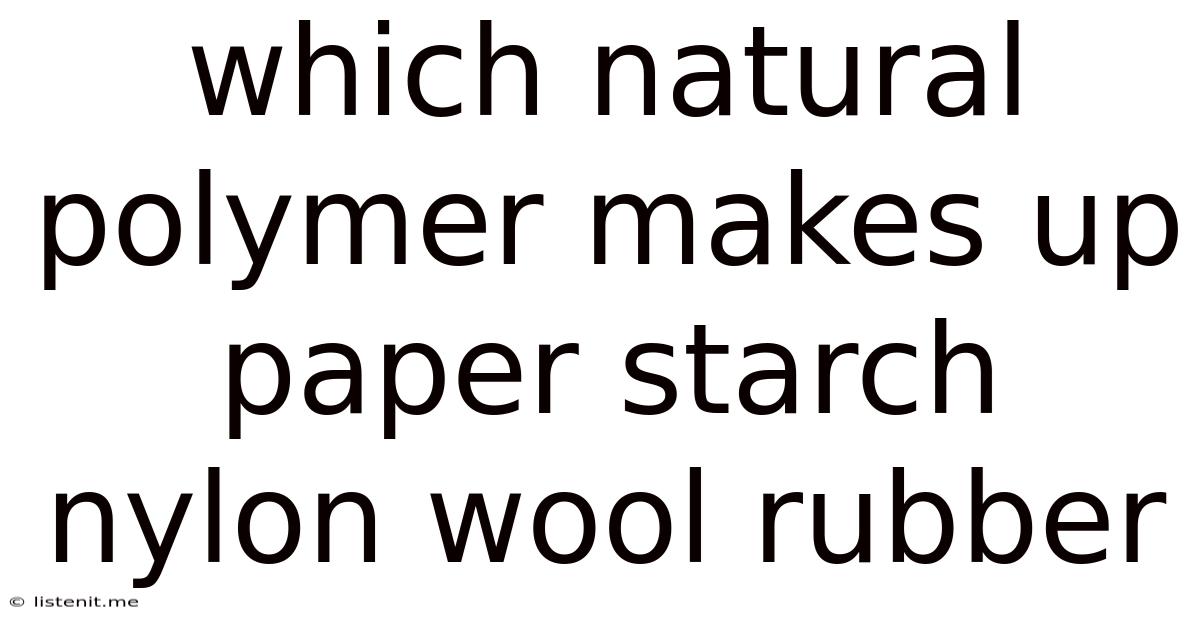Which Natural Polymer Makes Up Paper Starch Nylon Wool Rubber
listenit
Jun 08, 2025 · 4 min read

Table of Contents
Which Natural Polymer Makes Up Paper? Starch, Nylon, Wool, Rubber?
The question, "Which natural polymer makes up paper?" presents a straightforward yet fascinating exploration into the world of natural polymers and their applications. While starch, nylon, wool, and rubber are all polymers, they possess vastly different properties and origins. Understanding these differences clarifies which polymer is the primary component of paper and the roles of the others in various applications.
Cellulose: The Backbone of Paper
The answer is cellulose. Cellulose is a natural polymer, a long chain of glucose molecules linked together, forming a strong, fibrous structure. This complex carbohydrate is the main structural component of plant cell walls, and it's this very structure that makes it the ideal material for paper production.
Understanding Cellulose's Properties
Cellulose's remarkable properties are what make it so suitable for papermaking:
-
Strength and Flexibility: The long, intertwined chains of cellulose molecules create strong fibers capable of withstanding considerable stress. This is crucial for the durability of paper. Simultaneously, these fibers can be interwoven and compressed to create a flexible sheet.
-
Hydrophilicity: Cellulose is hydrophilic, meaning it readily absorbs water. This property is important during the papermaking process, allowing for the dispersion of fibers and their bonding together. However, excessive water absorption can also lead to paper damage or degradation.
-
Biodegradability: Cellulose is a biodegradable polymer, meaning it naturally decomposes over time. This makes paper relatively environmentally friendly compared to synthetic materials.
-
Abundance: Cellulose is arguably the most abundant organic polymer on Earth, readily available from various plant sources, making it a sustainable and cost-effective raw material.
The Papermaking Process and Cellulose
The papermaking process relies heavily on the unique properties of cellulose. Wood pulp, typically derived from softwoods (like pine and spruce) or hardwoods (like eucalyptus), is the primary source of cellulose. This pulp undergoes various treatments to separate and isolate the cellulose fibers. These fibers are then suspended in water, refined to improve their bonding properties, and finally spread onto a mesh screen where water drains, leaving behind a matted layer of cellulose fibers. This layer is then pressed and dried, resulting in the sheet of paper we are familiar with.
Distinguishing Cellulose from Other Polymers
Let's contrast cellulose with the other polymers mentioned – starch, nylon, wool, and rubber – to further emphasize its role in paper production.
Starch: A Different Carbohydrate Polymer
Starch, like cellulose, is a carbohydrate polymer. However, its structure differs significantly. Starch comprises shorter chains of glucose molecules, arranged in a less organized manner than cellulose. This leads to a less robust and more easily digestible material. While starch can find applications in paper coatings or adhesives, it's not the primary structural component.
Nylon: A Synthetic Polyamide
Nylon is a completely synthetic polymer, not a natural one. It's a polyamide, formed through the polymerization of diamines and diacids. Nylon is known for its strength, elasticity, and resistance to abrasion, making it suitable for clothing, carpets, and various industrial applications. However, it has no direct role in paper production.
Wool: A Natural Protein Polymer
Wool is a natural protein polymer, primarily composed of keratin. Keratin is a complex protein with a unique structure that contributes to wool's softness, elasticity, and warmth. Wool fibers are entirely different in structure and composition from cellulose fibers and are used in textiles, not papermaking.
Rubber: A Natural Isoprene Polymer
Rubber, mainly natural rubber, is a natural polymer composed of isoprene units. It's known for its elasticity and ability to stretch and return to its original shape. Rubber's properties are exploited in tires, seals, and many other applications far removed from the manufacturing of paper.
The Importance of Refining and Processing Cellulose for Paper Quality
The quality of paper depends not just on the cellulose content but also on the refinement and processing of the cellulose fibers. Various techniques are employed to ensure the paper possesses the desired characteristics:
-
Mechanical Pulping: This method grinds wood chips to create pulp, retaining many lignin components. The resulting paper is typically less strong and more prone to yellowing but is less expensive to produce.
-
Chemical Pulping: This involves treating wood chips with chemicals (such as sulfate or sulfite) to remove lignin and isolate cellulose fibers. This process yields higher-quality paper with greater strength, brightness, and durability.
-
Bleaching: Bleaching processes are used to remove residual lignin and other colorants, resulting in a brighter, whiter paper.
-
Sizing: Sizing agents are often added to paper to control its absorbency and improve its printability.
Conclusion: Cellulose – The Unsung Hero of Paper
In conclusion, the natural polymer that makes up paper is cellulose. Its unique properties of strength, flexibility, hydrophilicity, and biodegradability make it the ideal material for paper production. While other polymers like starch, nylon, wool, and rubber exist with distinct applications and characteristics, they play no role in the fundamental structure of paper itself. Understanding the importance of cellulose and the papermaking process highlights the remarkable properties of this abundant natural polymer and its vital role in our daily lives. The diverse refining and processing techniques further emphasize the sophisticated nature of paper production and its adaptability to various needs and quality standards.
Latest Posts
Latest Posts
-
Chromosome 11 Is Made Of Over Million Base Pairs
Jun 08, 2025
-
Nursing Diagnosis For Peripheral Vascular Disease
Jun 08, 2025
-
In The Epiphyseal Plate Cartilage Grows
Jun 08, 2025
-
Homeopathic Remedy For Colic In Infants
Jun 08, 2025
-
What Is A Diagnosis Of Exclusion
Jun 08, 2025
Related Post
Thank you for visiting our website which covers about Which Natural Polymer Makes Up Paper Starch Nylon Wool Rubber . We hope the information provided has been useful to you. Feel free to contact us if you have any questions or need further assistance. See you next time and don't miss to bookmark.